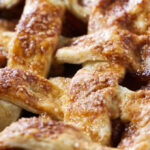All Butter Pie Crust
Whether you're making a single pie crust or double, our recipe is easy to follow and yields the perfect flaky tender crust that will make your pies taste out-of-this world.Larger chunks of butter in the dough will give you a flakier crust while smaller chunks will make the dough easier to handle. The optional baking powder helps puff the dough and gives it a flakier texture.
Servings: 8 Servings
Ingredients
Single Crust Pie
- 1-½ cups flour 180 grams**
- 1 tablespoon sugar (optional)
- ½ teaspoon salt
- ½ teaspoon baking powder*
- 10 tablespoons cold butter
- 3 to 4 tablespoons of ice water
Double Crust Pie
- 3 cups flour 360 grams**
- 2 tablespoons sugar (optional)
- 1 teaspoon salt
- 1 teaspoon baking powder*
- 20 tablespoons cold butter
- 6 to 7 tablespoons ice water
Instructions
- Combine the flour, sugar if using, salt, and baking powder in a bowl. Cut the butter into cubes and toss half of it into the flour mixture. Use a pastry blender (or you can use a food processor) to cut the butter into the flour. Blend it really well until it looks like cornmeal. Add the rest of the butter. Continue to blend the butter until it looks like coarse cornmeal with pea-size lumps.
- Drizzle the ice water into the mixture one tablespoon at a time. Stir the mixture with a rubber spatula after each addition of water. Test the dough by squeezing a small amount in your hand. If it doesn’t hold together, continue adding more ice water. When the mixture holds together after you squeeze it, stop adding water. It should still look clumpy and rough at this point. The less water you add, the more tender and flaky the crust will be so stop adding water as soon as the dough holds together when you squeeze it.
- Dump the dough onto the counter and push it together into a ball.
- If you are making a double-crust pie, cut the ball in half and shape each half into a disk.
- Wrap the dough in plastic wrap and let it chill in the fridge for at least 30 minutes.
To roll the dough out:
- When it is time to roll the dough, let it rest on the counter for 20 to 30 minutes if it is too cold to work with.
- Place the dough on a floured counter. Dust the top of the dough and your rolling pin with more flour.
- Roll the dough into a 12-inch circle. Lift and turn the dough as you roll, keeping the dough lightly dusted with flour.
- Wrap the dough around your rolling pin to transfer it to a pie plate (alternatively, you can slide a thin cutting mat under the dough to lift and transfer it).
- Gently ease the dough into the pie dish by lifting the edges and allowing the dough to fall into the dish without stretching it (if you stretch the dough, it will shrink when you bake it).
- Trim and crimp the edges of the dough. Use a fork to prick holes in the bottom of the pie shell if you plan to pre-bake the crust.
- Place the pie shell in the freezer for 30 minutes or in the fridge for 1 hour or until it gets firm and cold.
- Preheat the oven to 400°F
To pre-bake the pie crust:
- Line the pie shell with parchment paper and fill it with pie weights.
- For a partially baked crust, bake for 10 to 15 minutes then transfer to a cooling rack and remove the pie weights.
- For a fully baked crust, bake for 10 to 15 minutes then remove the pie weights and continue baking for another 10 to 20 more minutes or until the crust is golden brown (Optionally, you can leave the pie weights in the shell for the entire baking time. However, the crust will not get quite as brown).
- Transfer the pie shell to a cooling rack and let cool for about 1 hour.
Notes
- You can use all-purpose flour or pastry flour for this recipe. Pastry flour will give the crust a slightly more tender texture.
- The baking powder is optional but it helps aerate the dough and give it a flakier texture.
- Don’t add too much water to the dough. Excess water will make the crust tough. The dough should look chunky and rough but will hold together when you squeeze it in your hand.
- You can store the dough in the refrigerator for 2 to 3 days or in the freezer for 3 months.
Nutrition
Serving: 1 | Calories: 273kcal | Carbohydrates: 36g | Protein: 5g | Fat: 12g | Saturated Fat: 7g | Polyunsaturated Fat: 4g | Cholesterol: 31mg | Sodium: 255mg | Fiber: 1g
